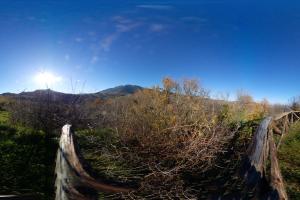Pietrarubbia
Primary tabs
Pietrarubbia
A theatre of epic clashes between atavistic enemies and fierce siblings of the Guelphs and Ghibellines, the town extends to the centre of a valley carved by hills and crossed by the River Apsa.
The ancient settlement called Castrum due to its ancient castle erected in the year one thousand has now disappeared, only ruins stand on a rocky cliff recalling its past role as a sentinel for Montefeltro.
The fierce struggles that mark the history of the Middle Ages are echoed in the legend of the castle that was dyed red by blood shed by the fallen: the episode alludes to the clash between the Guelph Count Taddeo, Lord of Pietrarubbia, and the Ghibelline branch of Urbino from which he had detached himself, creating a fight that led to the siege at the castle.
In fact, the name Pietrarubbia comes from a pink plant called "robbia" or alternatively the natural red color of the local stone building methods, called "petra rubea", consisting of rounded cobblestones cemented together.
Like the other towns that open in Montefeltro's mountainous heart, Petrarubbia in the past underwent Malatesta's dominion and then, in the fifteenth century, the domination of Federico da Montefeltro, thus becoming part of the duchy of Urbino until its annexation to the Holy State in 1631.
The ruins of the ancient castle and its imposing tower are the only testimony to the warrior spirit of its ancestors, whilst there is however the XII century church of Sant'Arduino, erected near a source of thermal waters, and the 16th-century St. Sylvester Convent.
The dizzying passage of the centuries has not, however, erased all the imprints of its past and of ancient historical events. The signs imprinted on the earth have recently been recovered and restored thanks to the patient and meticulous work of sculptor Arnaldo Pomodoro who founded the Tam Center (Centre for the Artistic Treatment of Metals) inside the ancient castle.
Pomodoro also carved the new marble altar and the great bronze sun in the church of St Sylvester, a parish of Pietrarubbia, whose dedication recalls the cult of Pope Sylvester II.
Today, the permanent exhibition of objects and sculptures made by Tam’s artists is open to visitors in the XIX century noble palace owned by the Fondazione Pomodoro. Inside the village there is also a Ceramic Museum with the display of carefully restored fragments that highlight the richness and variety of dishes and mouthpieces in different historical periods, one can admire a rare medieval steel complex which presents the cycle of iron processing and the interesting multimedia museum.
The cultural liveliness of the medieval village explodes during the Gustantico festival, in early August and the Market events, held in December in memory of the ancient cattle fairs.








